Chris McLaughlin joined the DNEG team in 2010. He has worked on a number of projects including John Carter, Terminator Genisys, Blade Runner 2049 and Deadpool 2.
How did you get involved on this movie?
I joined Venom: Let There Be Carnage as DNEG Supervisor during pre-production. DNEG was already pitching on the show with concept art and an animation test overseen by VFX Supervisor Paul Franklin and Animation Director Aaron Gilman, showing a more visceral, aggressive style of animation in Venom.
By this time, DNEG’s Art Department had already produced a lot of concept art for Carnage, and Spencer Cook had also joined the show as DNEG Animation Director.
We immediately got to work restoring/evaluating the assets from the first film (which DNEG also worked on) and producing animation tests for Carnage, before I relocated to London where I joined Sheena [Duggal] and her team for principal photography.
How was the collaboration with Director Andy Serkis and Overall VFX Supervisor Sheena Duggal?
Throughout the shoot Andy was an absolute joy to work with, very collaborative and open to suggestion.
Sheena was very involved and made it clear to us from the very beginning that she expected us to surpass the work that had been done on the first film.
DNEG was awarded all shots with Venom (including Wraith Venom, She Venom, Mrs. Chen Venom), and 3 sequences with Carnage (San Quentin, outside Eddies apartment and the Cathedral sequence). We also designed and built the Carnage asset.
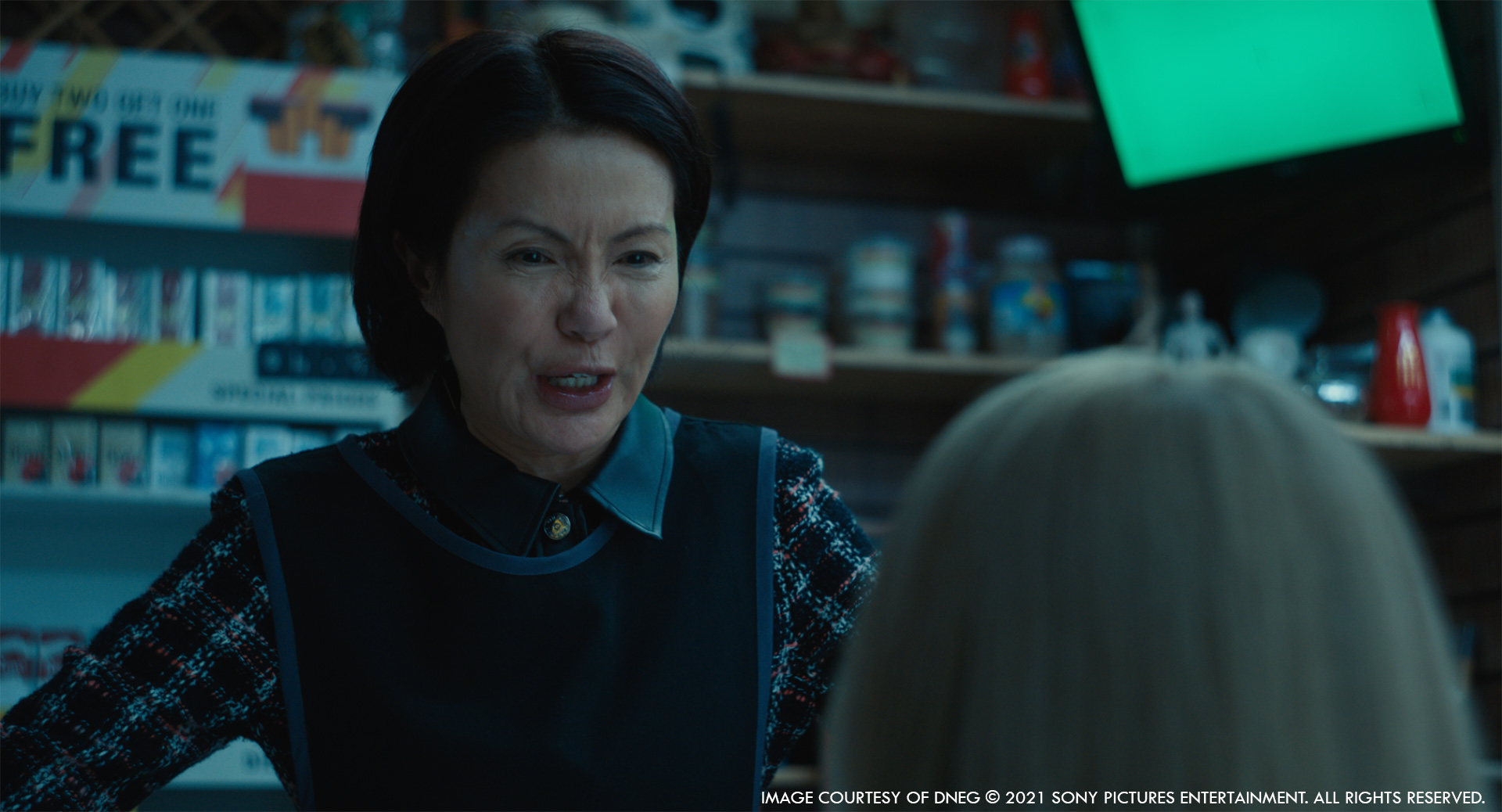
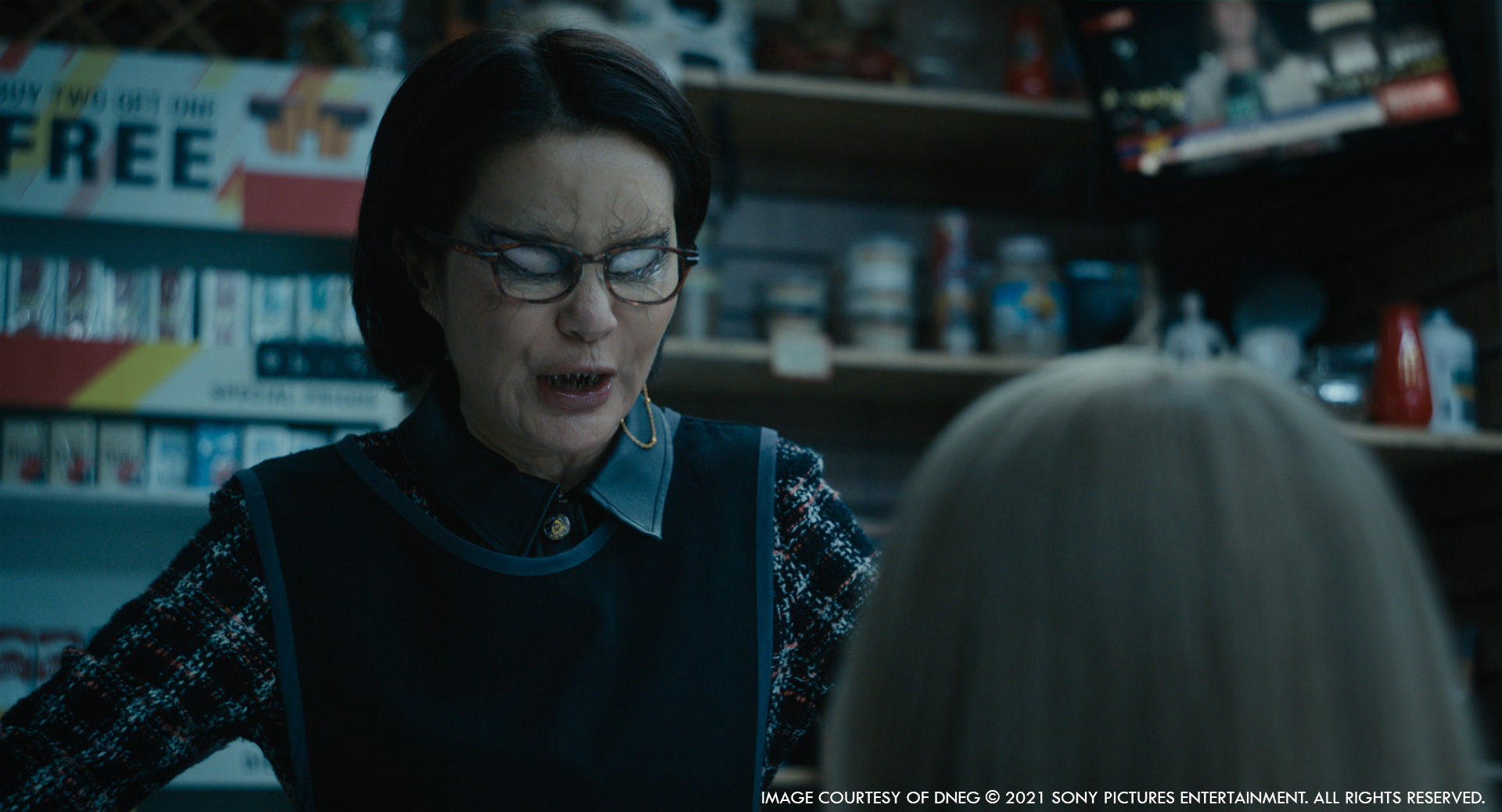
How did you organize the work between the DNEG offices and with your VFX Producer?
David Fox was VFX Producer here in Vancouver (which served as the show’s production hub). We hadn’t worked together before this show, but working alongside each other every day for the best part of 2 years, we soon got to know each other well! David is very pragmatic, and is extremely calm in the face of adversity. I was very pleased to partner with him on the show.
In terms of organizing the work, our approach was to keep specific sequences worked on in specific sites, with some key lookdev and development shots (e.g., the Carnage transformation shots) kept in Vancouver. This was a truly global show for DNEG with work being carried out in Vancouver, Montreal, London and Mumbai.
The Vancouver team, worked on the cathedral sequence, supervised by Russel Bowen, who also led the build and development of our Carnage asset. The Montreal team, worked on a variety of sequences, including the San Quentin sequence, and was supervised by Francois Lambert. The London team, supervised by Dan Pastore, helped out with a lot of the exterior cathedral shots, and some of the more demanding transformation shots. The rest of our work was done by our team in Mumbai and was supervised by Michael Grobe. Spencer Cook, our animation Director in Montreal, oversaw and reviewed all animation on the show.
I would do internal reviews with the global teams throughout the day, starting with London in the morning, then with the Canadian teams through the day, and finishing with India at the end of the day. This would be done on DNEGs internal version of RV. Meanwhile, I would also regularly be presenting and reviewing work with Sheena and her team via cineSync.
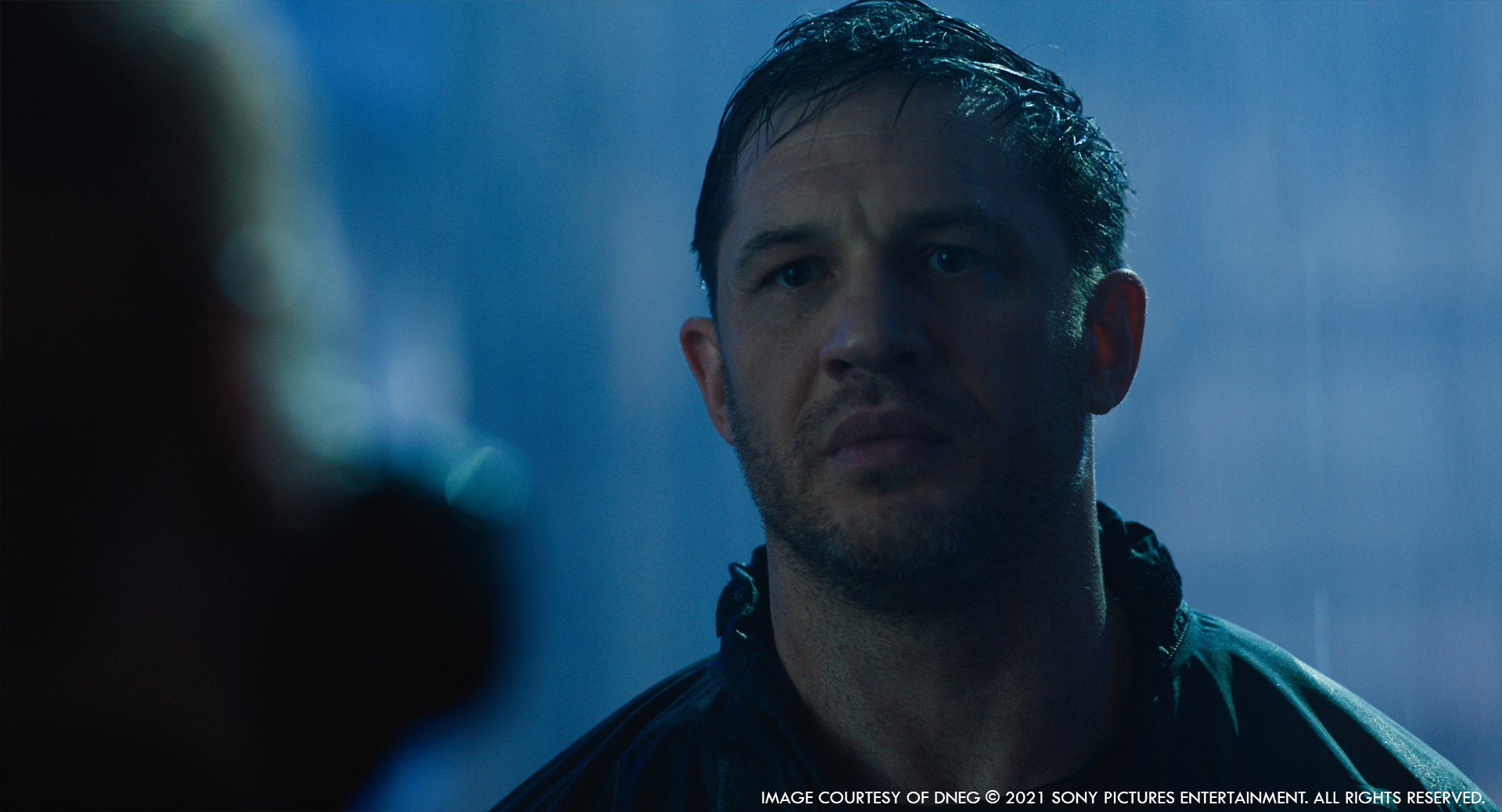
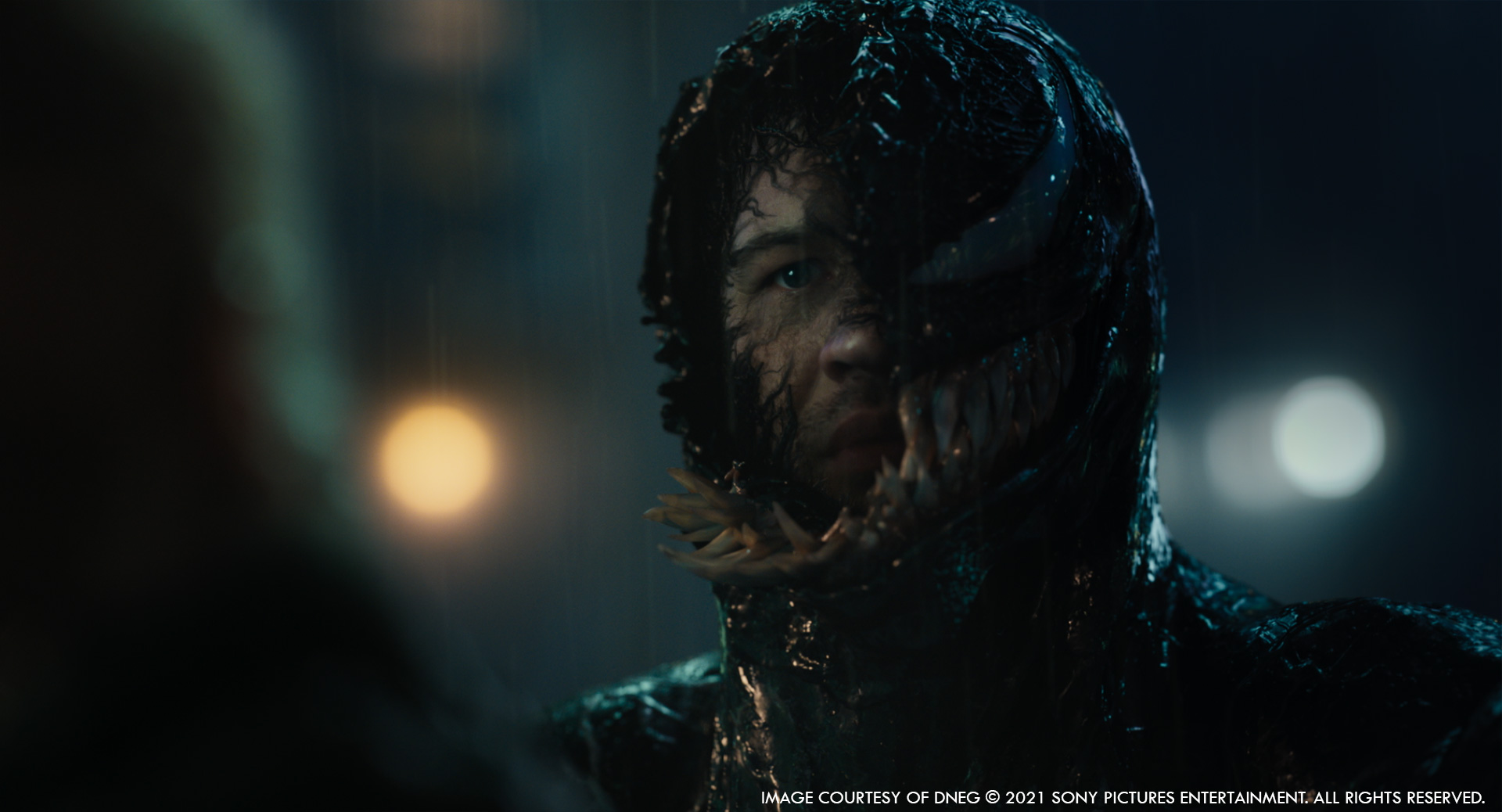
DNEG worked on the first movie. How did you enhance the Venom model since the previous movie?
The Venom model is almost unchanged since the first movie – his head has gotten very slightly larger and his shoulders and traps have gotten slightly smaller, but overall the textures and lookdev are pretty much the same. The main changes to Venom are all ‘under the hood’. DNEG’s creature pipeline has had quite an overhaul since the first film, so the rig has been updated substantially. The facial rig was rebuilt from scratch, as was the muscle system which now uses a three layer (muscle/fat/skin) soft-tissue simulation.
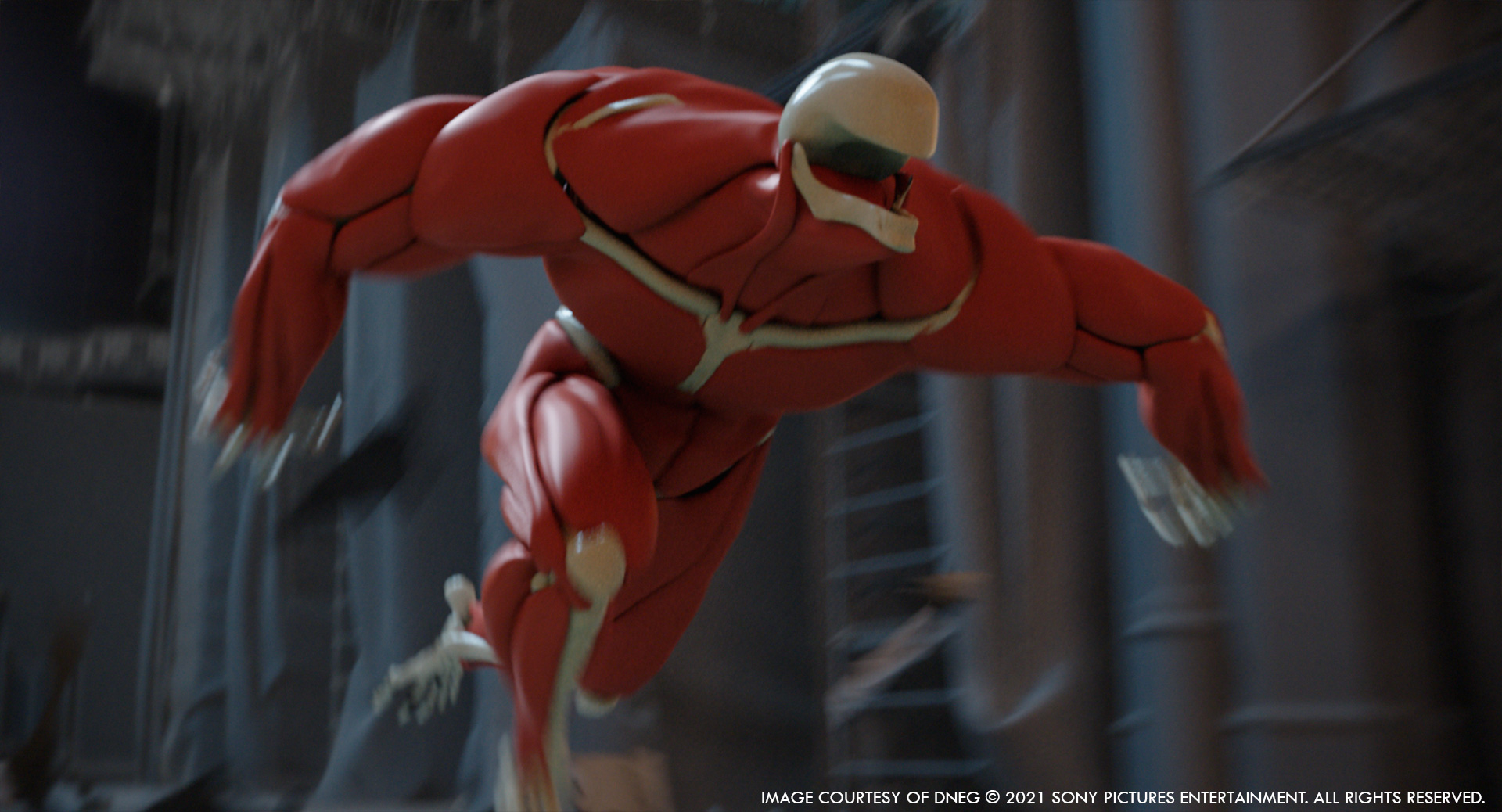
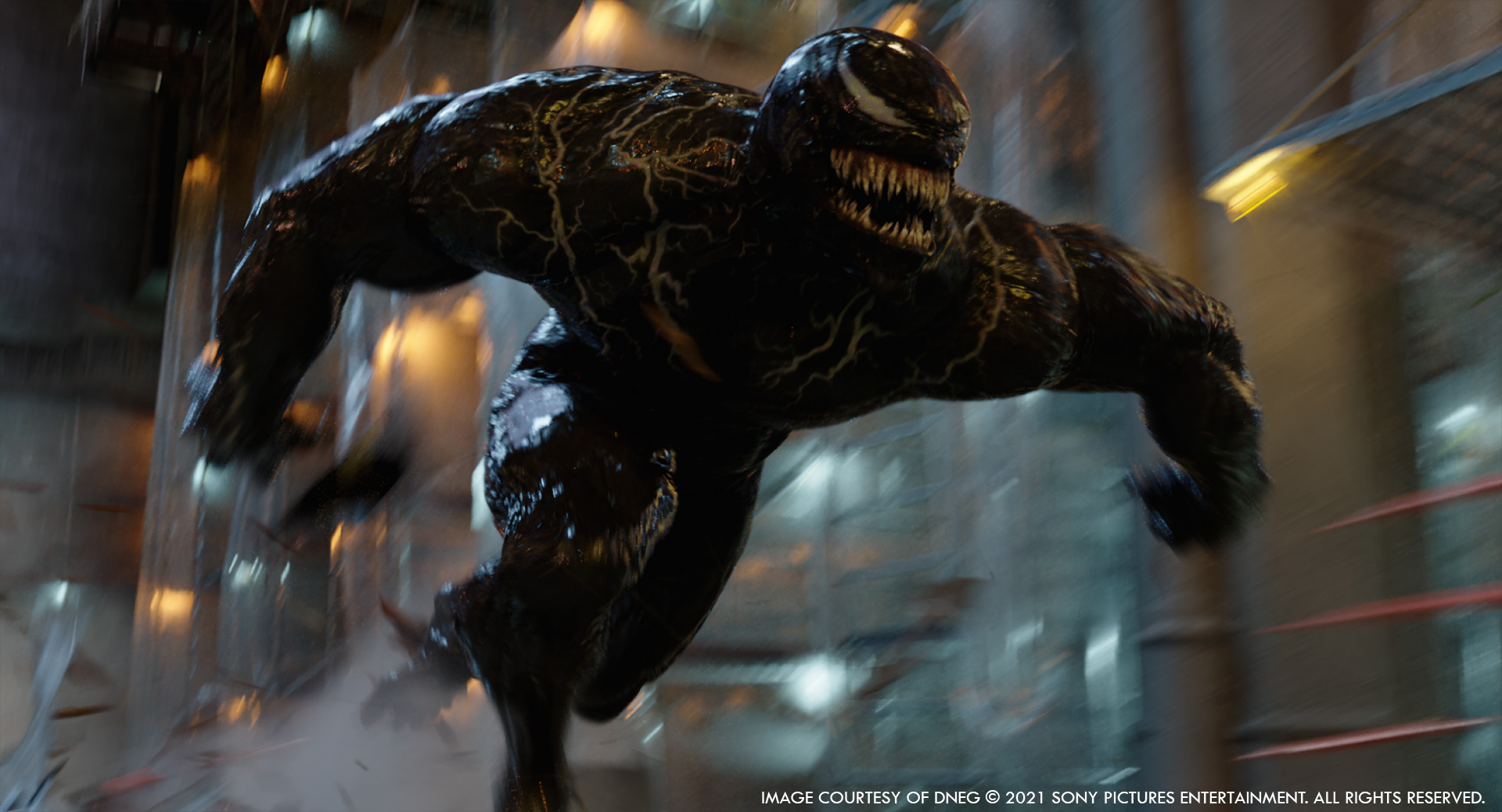
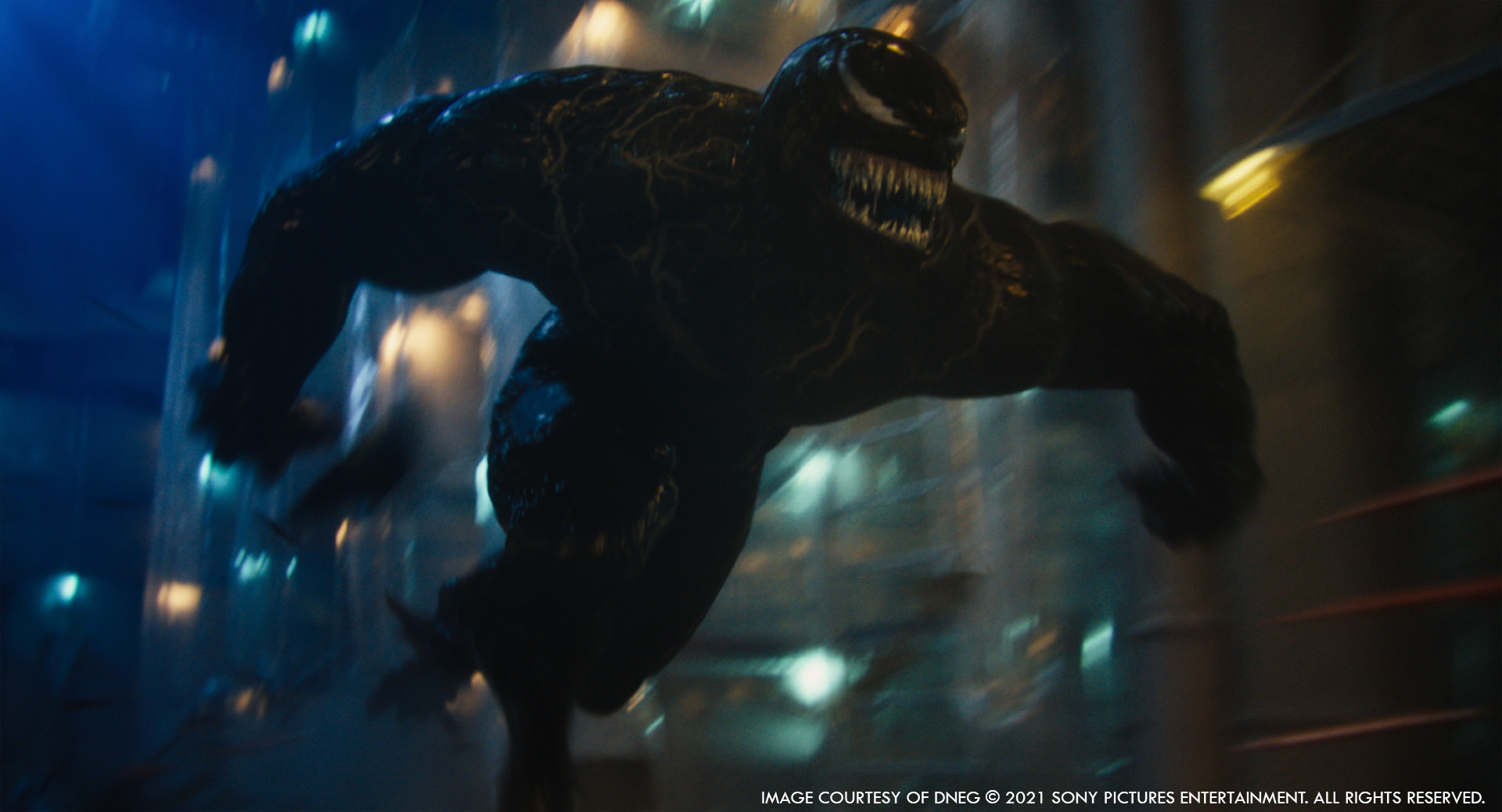
Did you proceed differently from the first movie on some specific aspect?
One thing that Sheena very specifically wanted to improve upon from the first film was cloth interaction, so a lot of work was put into simulating the interaction between Eddies’ costume and the Venom tentacles/wraith. This is most evident in the sequences in Eddie’s apartment, where you can really read the tentacle connection tugging on the fabric of his bathrobe.
The FX simulation of the wraith Venom caused us some headaches this time round. The animation of the wraith in the first film was really quite languid and free-flowing. In this film the animation is much more active and energetic, so we had to rework the simulation settings on the wraith so the fluids would behave appropriately. To be honest this caused us more headaches than I’d have cared for, but we got there in the end!
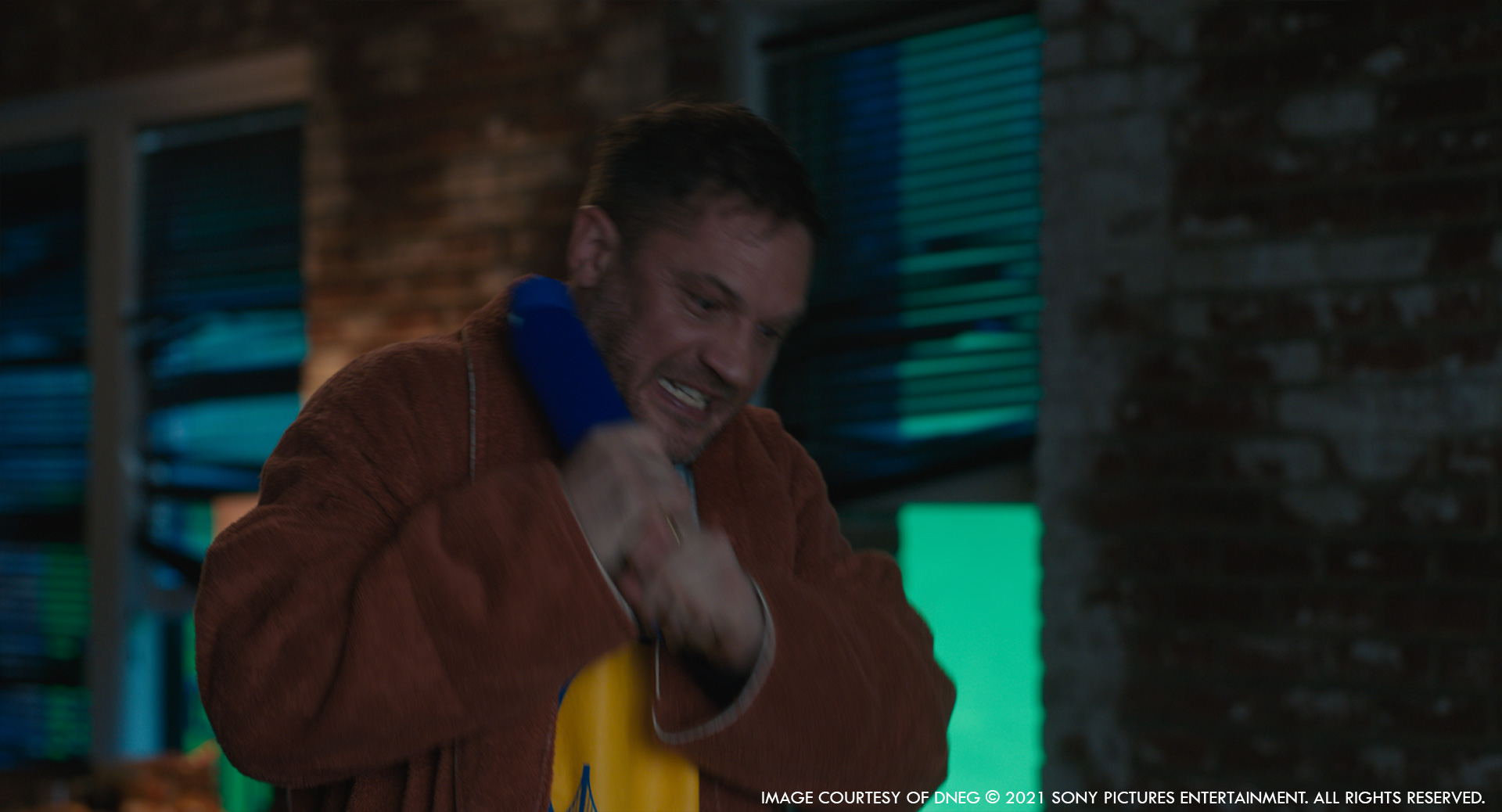
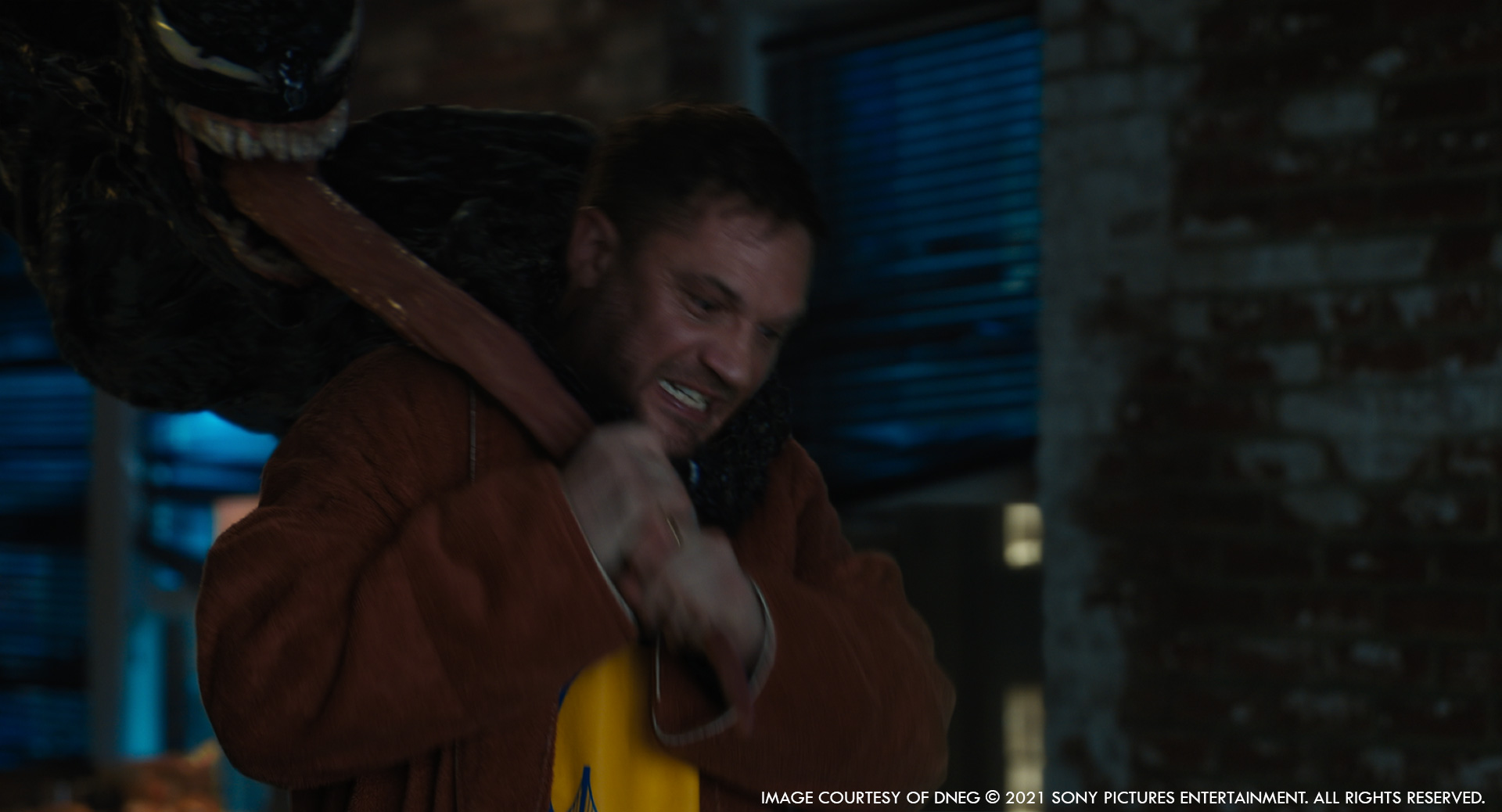
Can you explain in detail about the creation of Venom and Carnage?
As mentioned previously, Venom was largely unchanged from the first film. For Carnage, obviously the comics were our first port of call when looking for inspiration – it was actually very interesting to look at the variety of interpretations of the character by many different artists over the years.
An abundance of concept art already existed from DNEG and the production team’s art departments by the time I’d joined the show, and work soon began on a maquette (from Sebastian Lochmann from KM Effects) that would combine the most favored elements from all of these concepts and would serve as the hero reference for our Carnage asset. Every detail was deliberated over, from the number of teeth to how red he should be. Connective tissue that would stretch and move with Carnage’s movement (inspired by real world reference images of muscle fibers) was added into the gaps between tendons and muscles. We had to be very careful that Carnage didn’t end up looking too much like a flayed man, or too ‘Hellraiser-esque’ – I think in the end it came close, but didn’t quite cross the line.
His face and mouth were designed at an extremely high level of detail, which proved invaluable later as we had quite a few extreme close ups. Unlike Venom, Carnage’s mouth design doesn’t really allow for lips, or at least lips that could close – he has these horrific teeth that were always visible in the comics (and are a big part of the design), so we had to make sure that we had extra articulation in the flesh around the teeth and the eyes, so that the animators had something to work with when syncing to dialogue and delivering performances. I think they did a great job with all the lip syncing, and I don’t think it ended up being an issue in the final shots, but it was definitely a big worry when we started working on the creature design. The sheer number of teeth in his mouth was also a real challenge for the rigging team, who had to be able to open and close his mouth, form shapes and deliver dialogue without the upper and lower level of teeth colliding.
Ryan Woodward supervised DNEG’s build team and Paul Boyd supervised our Creature team. Lucas Cuenca modelled our hero sculpt in Zbrush (which was based on the maquette), and then transferred that to a simpler topology in Maya, with the higher level details retained in displacement maps. Grace ‘Stevie’ Stephens was our texture artist and Erik Gronfeldt was our lookdev artist. They worked incredibly hard to add some subtle variation into the base colour, a layer of subcutaneous veins and a wet, fleshy look to his skin.
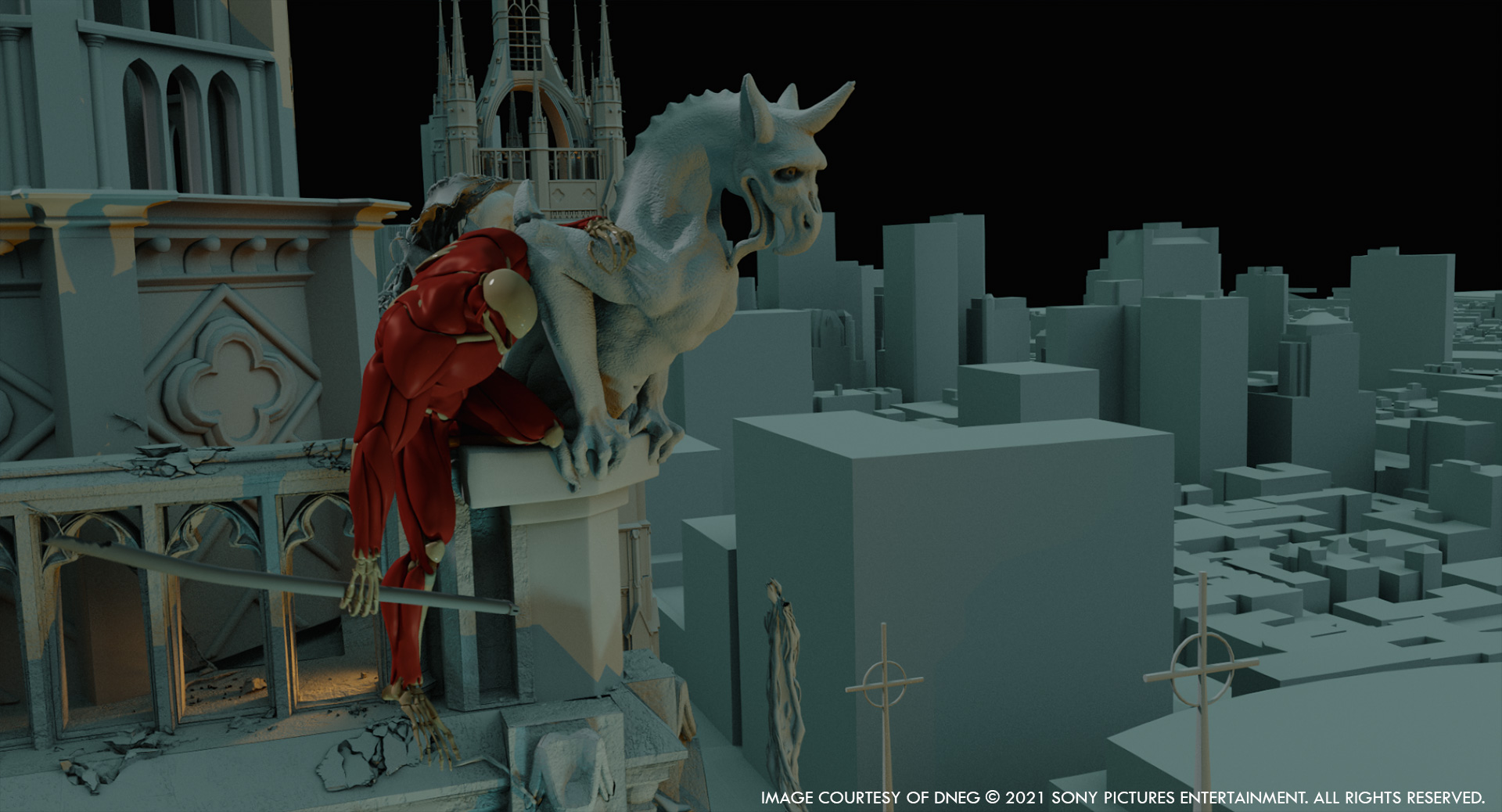
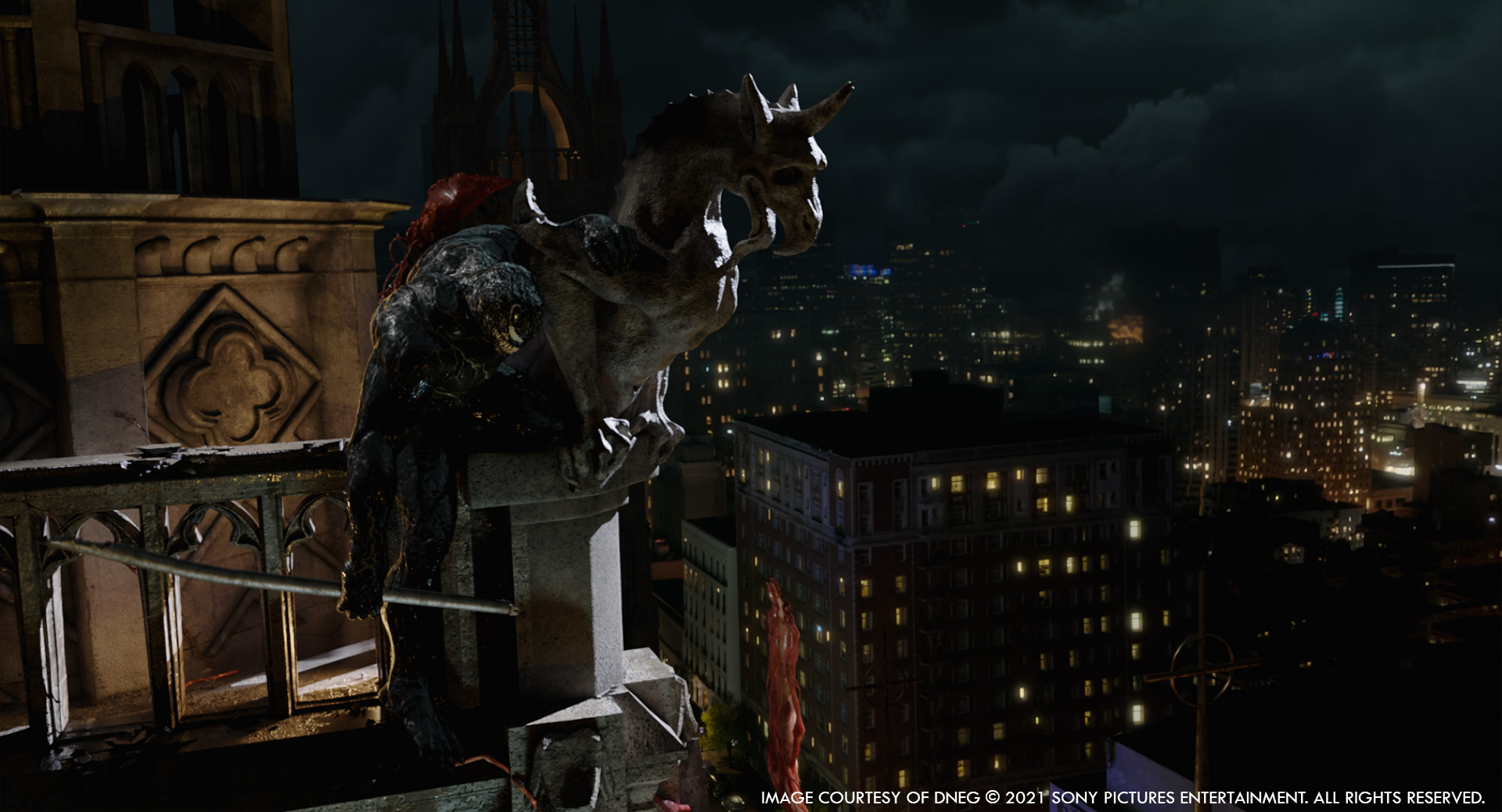
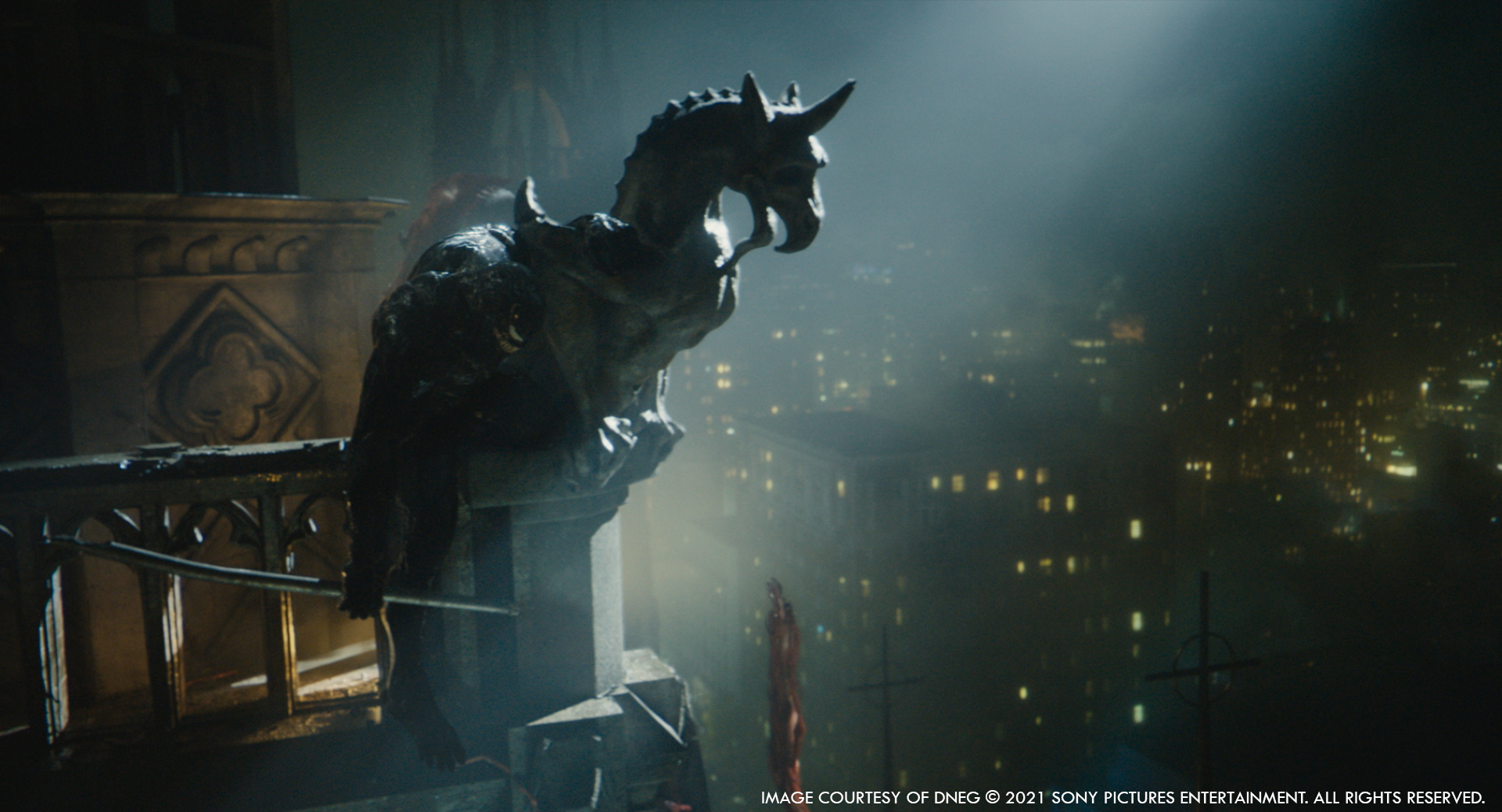
Meanwhile, while Carnage’s base model was being worked on, DNEG’s creature and FX teams were devising methods to allow him to extend his limbs, grow tentacles and form weapons. The tentacles in fact were a huge technical undertaking for our animation and FX departments. Tentacles (or ropes, or chains, or any rig with a multitude of points of articulation) are notoriously difficult and slow to animate, and had tested our animation team on previous shows, but luckily by the time we had started this show, DNEG’s creature team had built a new rig that considerably sped up our tentacle workflow. This rig was used for his back tentacles, or any single tentacle that Carnage used at any time. We had multiple weapon attachments for tentacles and limbs that could be easily switched out and alternated at the animation stage. For multiple branching tentacles, which would have simply been too time consuming for the animation team to individually animate, Houdini engine (which allows us to use Houdini toolsets within Maya) was put to use to allow the animators to use a procedural method to easily manipulate multiple branches. I believe this was the first time that DNEG had used the Houdini engine within our pipeline, and it proved very successful.
Lastly, there were what we called the ‘L-systems’ tentacles, which feature toward the end of the film as Carnage is growing and spreading his mass throughout the cathedral. The idea behind these tentacles was that as Carnage grows, he uses them to increase his size and volume, and these tentacles in turn start to mimic and inhabit the environment around him. These were blocked out with larger single strand tentacles by our animators in Maya, and passed to the FX team where our Houdini setup would recursively iterate within and around that volume, building recursive branches, giving them the veiny, snake-like look as they interact with and grow upon the cathedral around them.
There really was a huge investment of time and effort that went into Carnage, but generally the feedback from fans of the character has been overwhelmingly positive, which makes it all worth it.
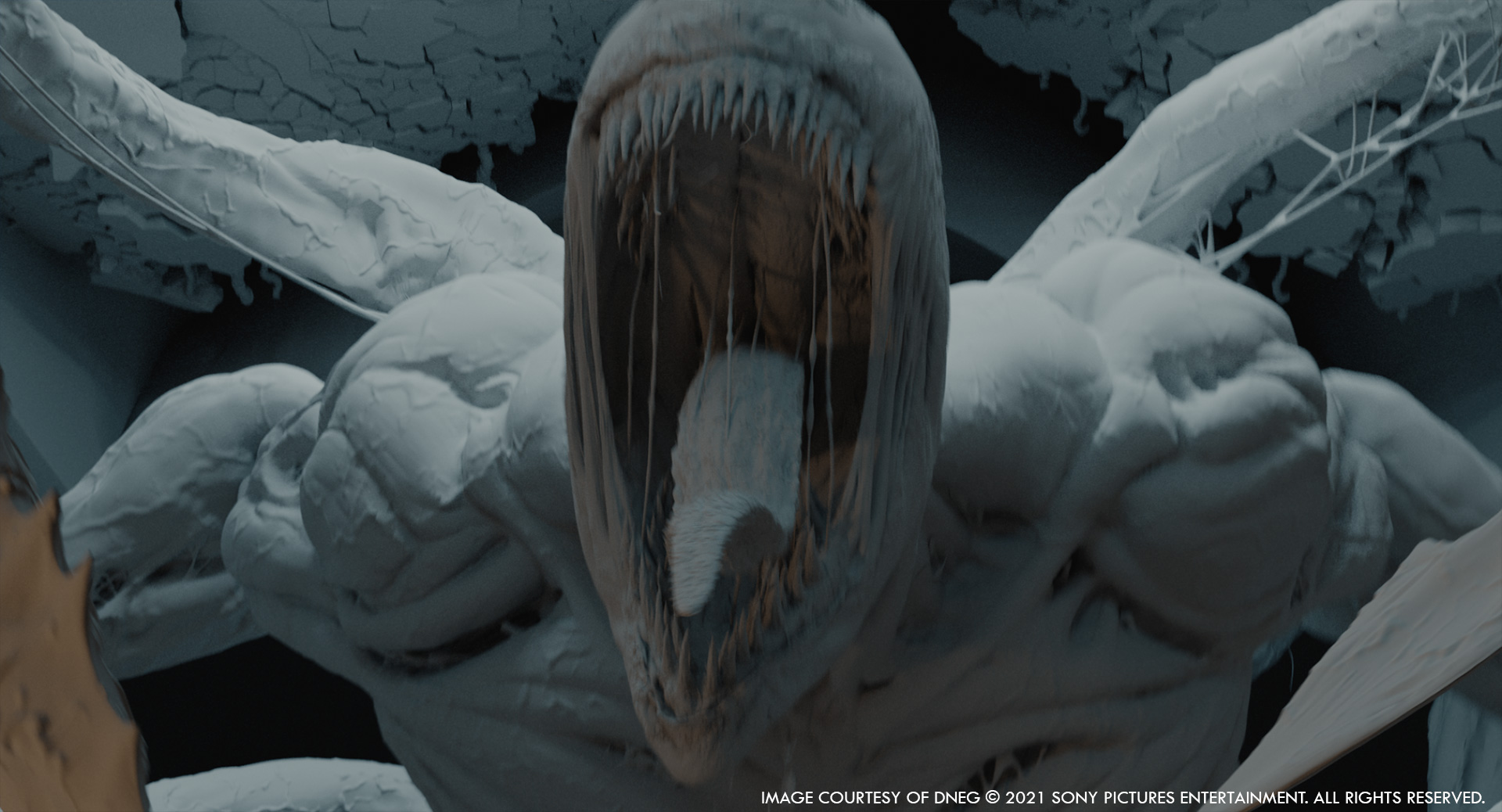
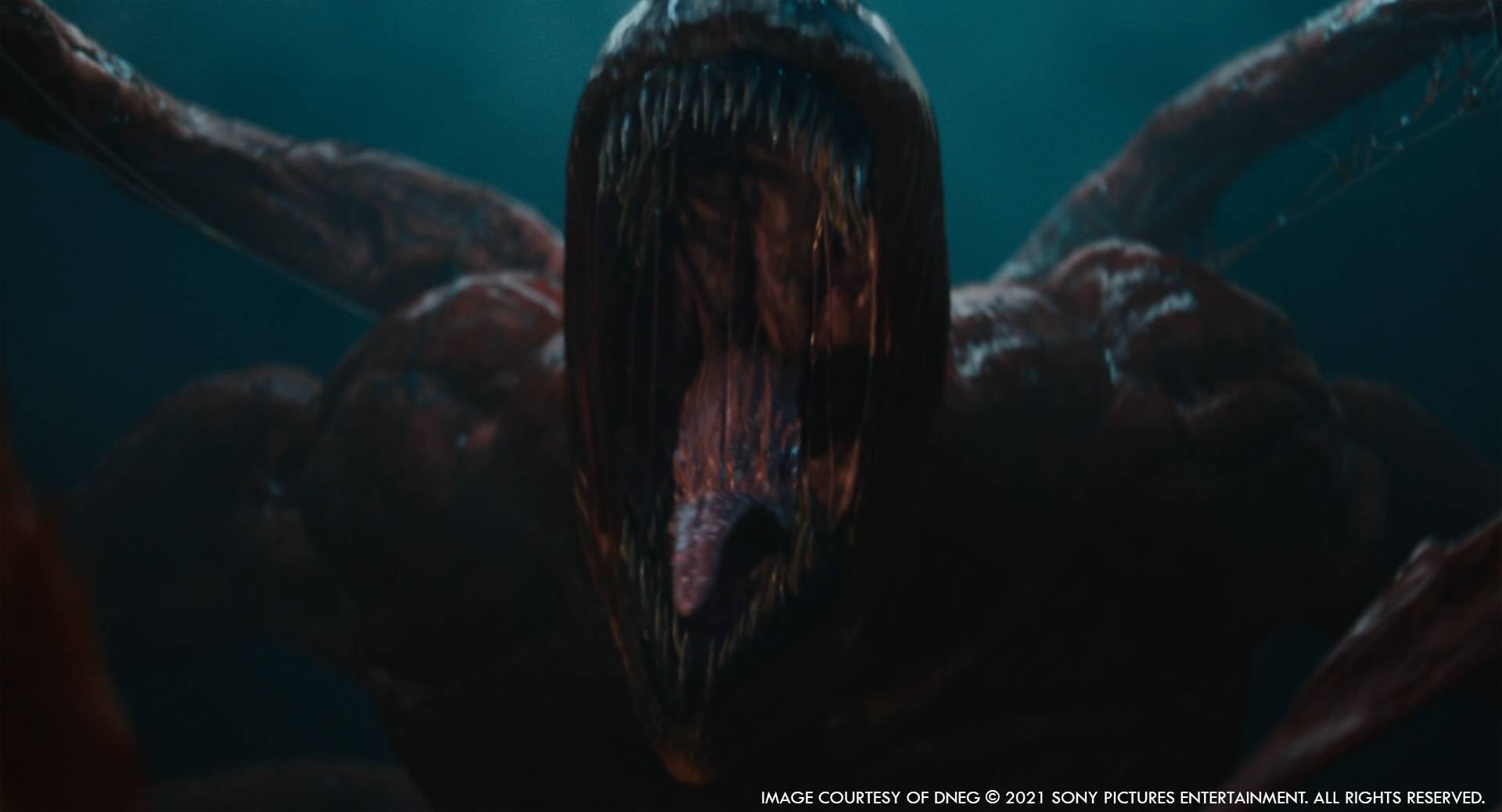
Andy Serkis has a lot of experience in animation. Did he ask for specific things about the characters animations?
Yes, and that experience was evident from the notes that came through from him – in general he just wanted to ensure ensuring that our characters felt believable, so we got notes on weight and performance. He also had some quite specific notes on facial articulation and lip syncs that he thought weren’t working, or for some face shapes he thought we weren’t quite hitting. So, he kindly sent through some short videos of himself delivering the lines as reference for our animators.
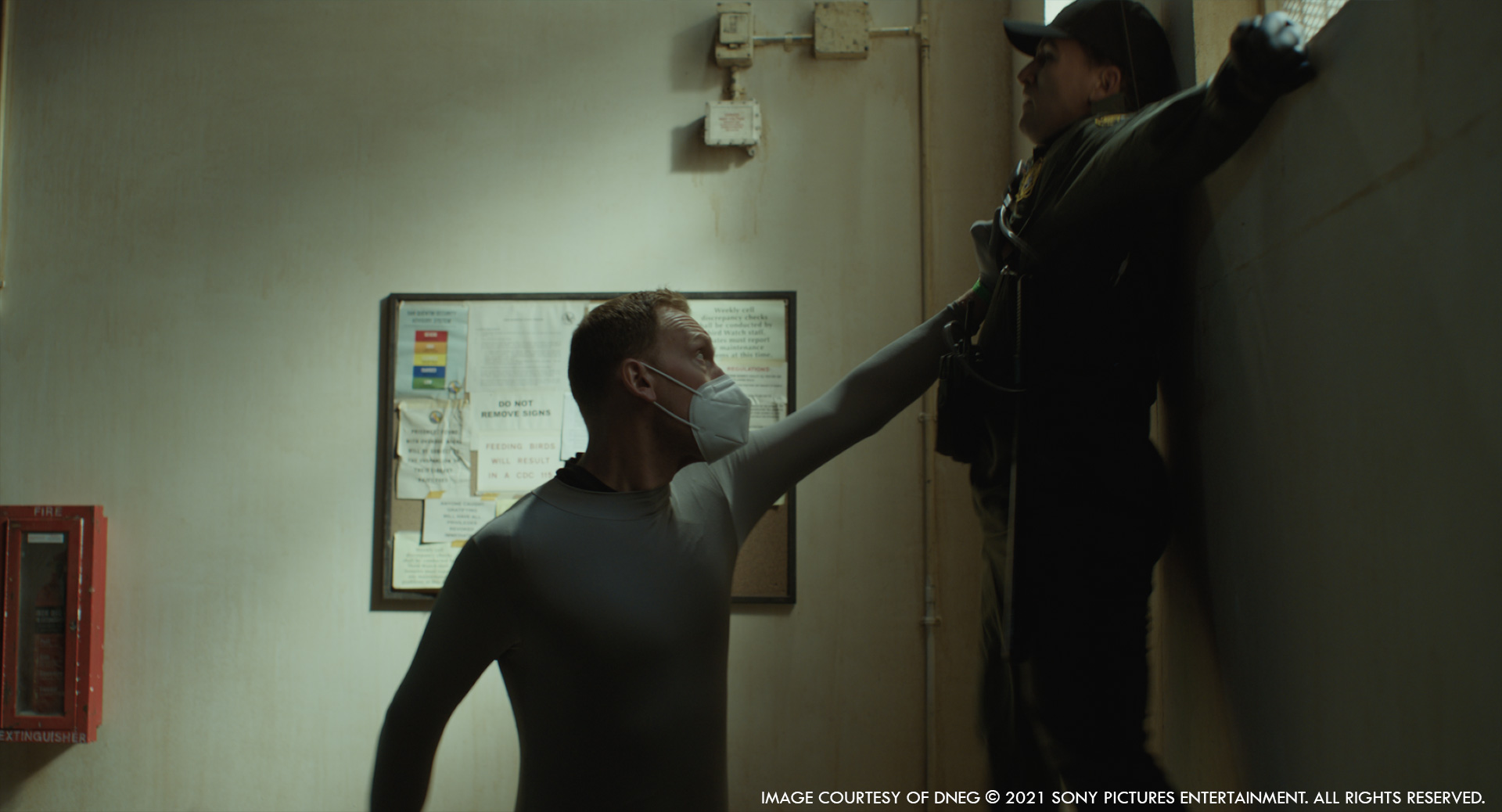
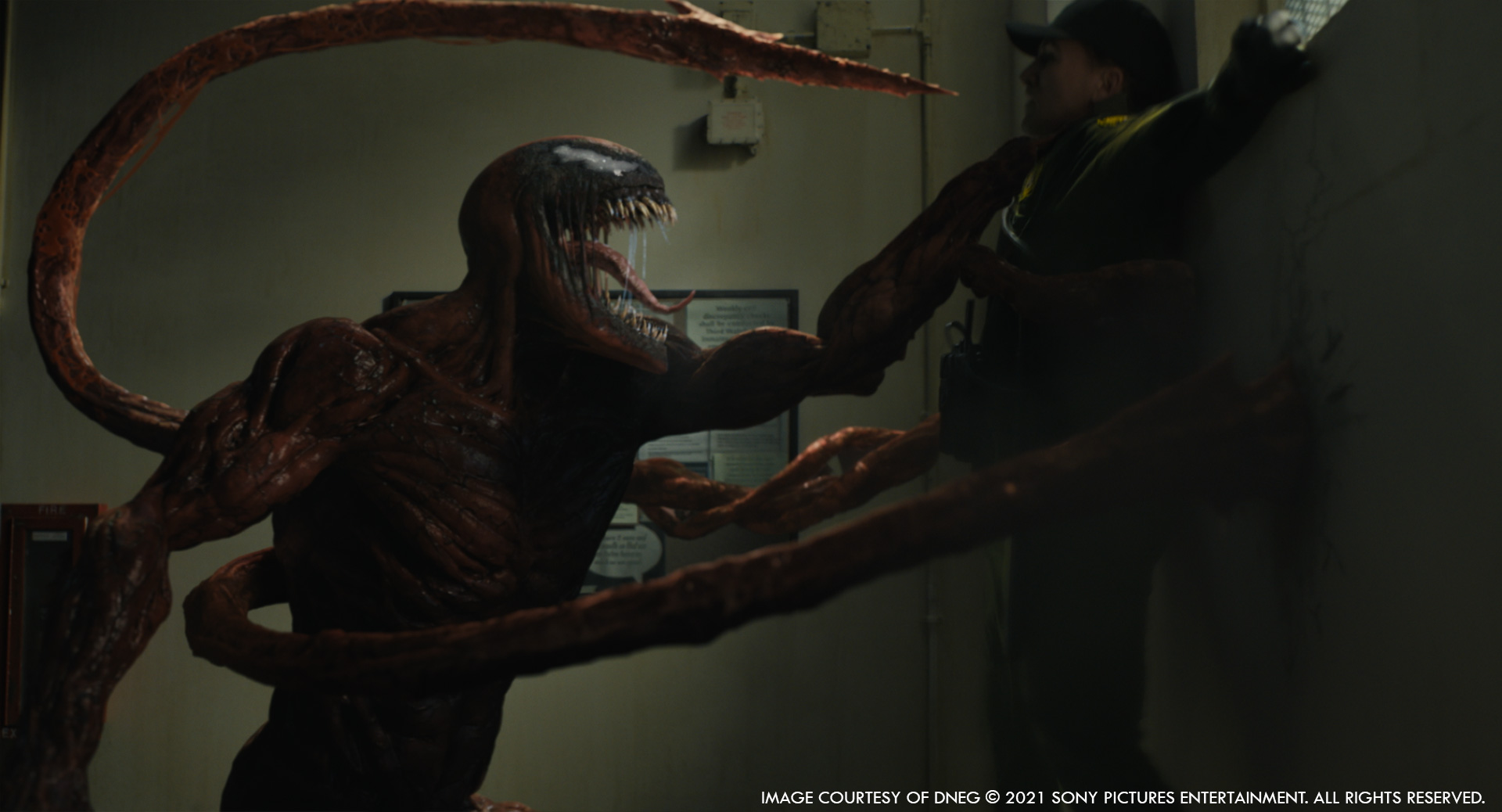
How did you handle the various fights between Venom and Carnage?
All the fights between Venom and Carnage happen in the cathedral sequence. Sheena and Andy worked closely with The Third Floor to produce a postvis that became the blueprint for our animation team. Ricardo Silva and Ben Wiggs, our Animation Supervisors in Vancouver took this as reference and would elaborate upon it, focusing on weight and timing, and adding secondary animation details.
Once the animation beats had been blocked out our FX team teams could start working on the interactive passes for any elements that Venom and Carnage come in to contact with in the fight and provide additional dust and atmos passes for the lighting team. All of these individual elements – animation, creature FX, destruction FX would then be refined and iterated on, and would be concurrently worked on by the lighting team and compositing teams.
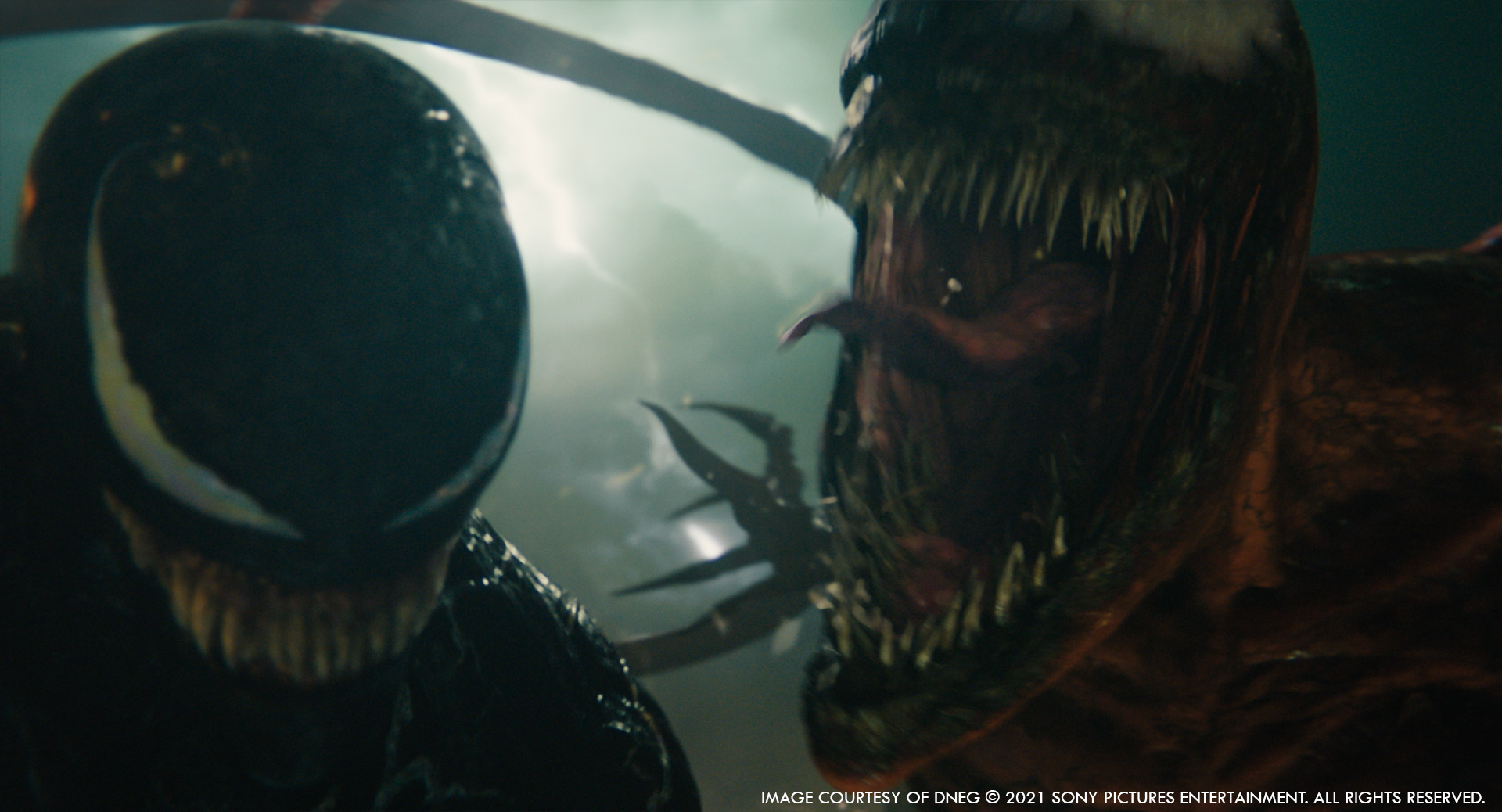
Can you elaborate about the various destructions caused by Carnage?
Once the action gets going in the Cathedral sequence, there is barely a shot that didn’t require some sort of FX destruction. Tiles were ripped from the floor, pews were smashed to pieces, plastic wraps were torn, concrete columns smashed, scaffolding collapsed and a massive hole is blown through the roof(!) – all of this had to be simulated, and the resultant destruction states had to be propagated throughout the sequence for continuity. Our CG Supervisor Eve Levasseur-Marineau was (amongst many other responsibilities) largely responsible for ensuring that this remained consistent and correct throughout the sequence.
How does the dark aspect of Venom skin affect your lighting work?
Well, we had learned from the first film that lighting Venom was difficult. The biggest issue is that essentially (in CG lighting terms), as a black reflective object, Venom doesn’t really have any diffuse component, and needs to be lit entirely by reflection. This can become problematic in an environment like the cathedral interior (which had over 500 light sources populating the scaffolding which surrounded the interior space), where Venom quickly got lit up like a Christmas tree, so our Lighting Supervisor Sushant Acharekar had to ensure that the light-rigs being used allowed us to control that.
In the end we found that large soft light sources were the most useful in shaping and defining Venom’s features, and the lighting team would always output a full set of AOVs for the comp team, sometime adding an additional ‘bling’ pass (an AOV with some additional light groups) which would allow the compositing team to add further shape and definition, eye reflections and just generally dial in the look of Venom.
With such a significant specular contribution, render noise was always a concern and we were fairly reliant on DNEG’s internal denoise system for the majority of our renders.
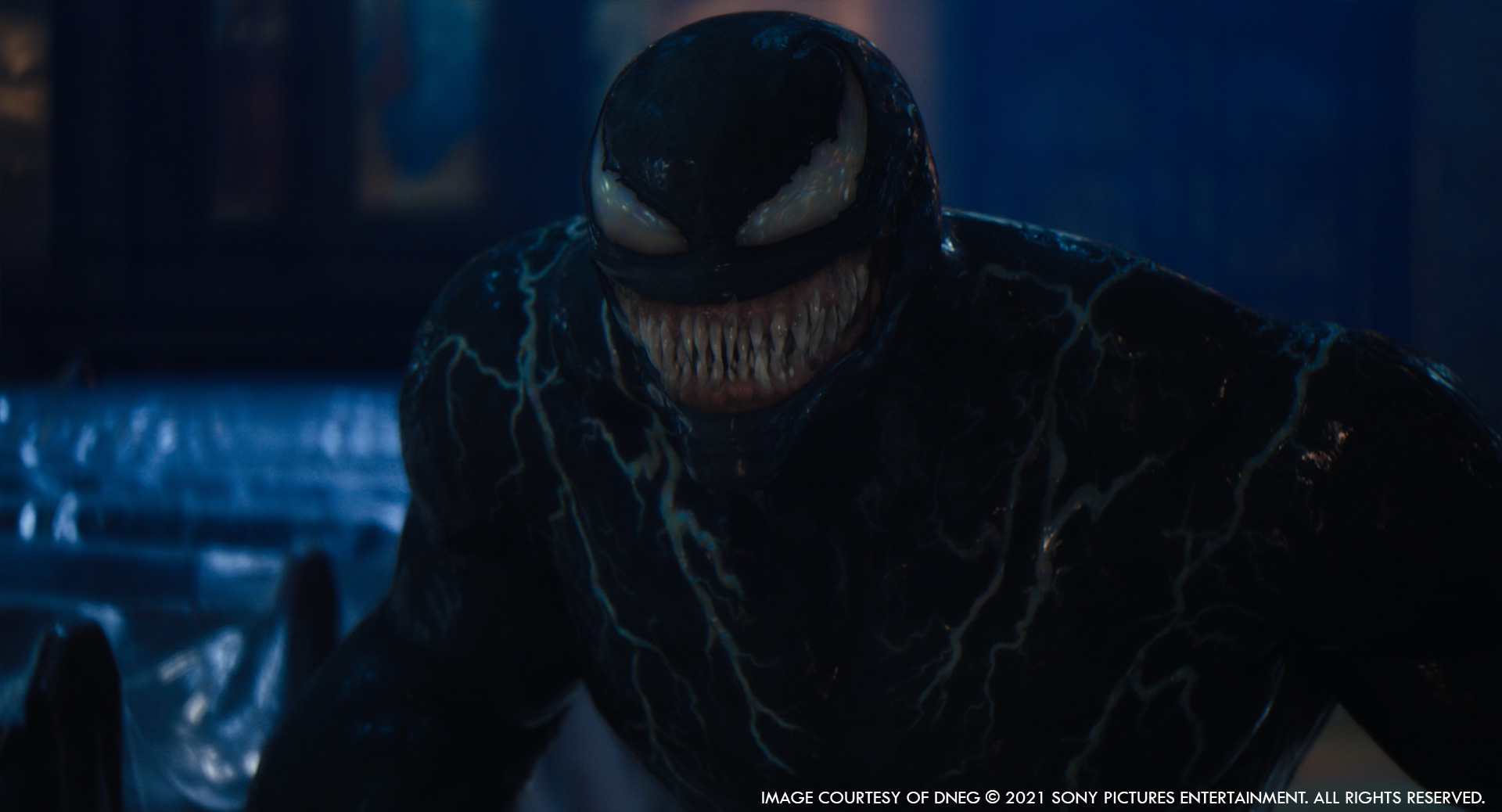
Which sequence or shot was the most challenging?
The cathedral sequence involved multiple transformations, lots of destruction, character performances with lots of dialogue delivery, set extensions on nearly every plate shot, a huge number of full CG shots and had a considerably larger shot count than any of our other sequences. I’m incredibly proud of the finished sequence and I think it stands as a testament to just how talented this team was and how hard everyone worked.
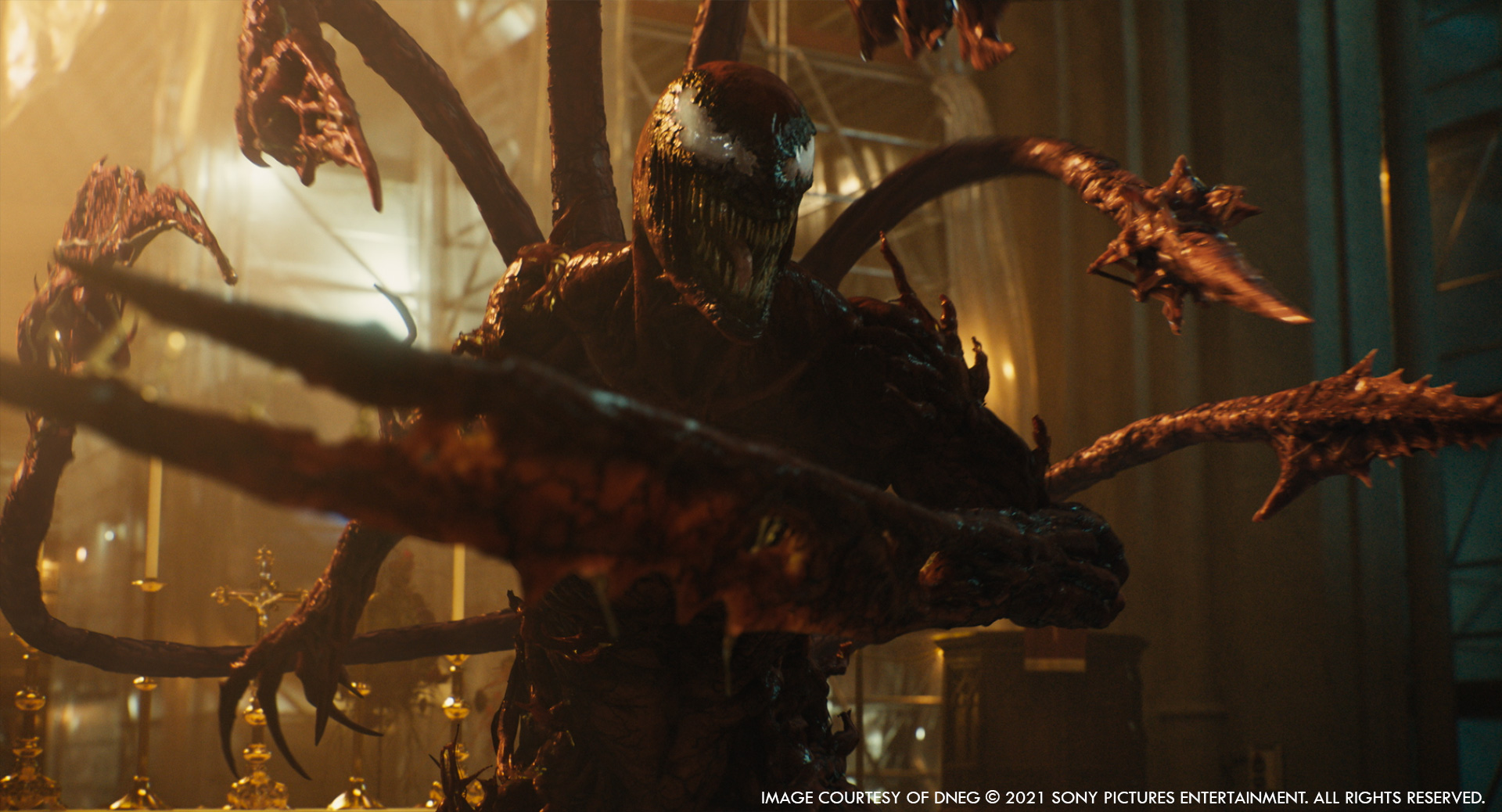
Did you want to reveal to us any other invisible effects?
In the sequences in Eddie’s apartment, anytime you see the tentacle or wraith connecting to his orange bathrobe, the bathrobe will be a CG takeover (either fully or partially depending in the shot). It took us some time to get that looking right, and in the end, we found the best solution was to create a hair sim (with over 5 million follicles) to recreate the tiny fabrics of the toweling material.
Also, I’d really love to give some recognition to the beautiful environment created for the Cathedral sequence. The cathedral itself was by-and-large matched to the existing Grace Cathedral in San Francisco, which had been extensively surveyed during the SF portion of the shoot. The main spire was extended to be taller, and scaffolding was added both inside and out. The scaffolding was covered in transparent sheet plastic, which was a challenge to our shading and rendering team. It took a while to get the look perfected, and the complex dielectric nature of the shader meant that it was extremely time consuming to render.
The interior and exterior were both built to a high level of detail, and all the set dressing from the set at Leavesden was matched and added to. Outside, the environment team built the city beyond Grace cathedral, and populated it with street furniture, moving traffic, and moving fog layers. With the asset in place, the lighting team then built upon the on set lighting, leaning into the warm key/cool fill directional lighting devised by the DOP Robert Richardson, with additional lighting from the stained-glass windows that exist throughout the cathedral.
The compositing team (supervised by Nik Brownlee, Stu Bruzek and Eric Chan) made use of many layers of atmospherics to really make use of the depth and help really get a sense of the volume of the space.
It was a huge team effort and I think all the individual contributions from various teams across the globe come together seamlessly.
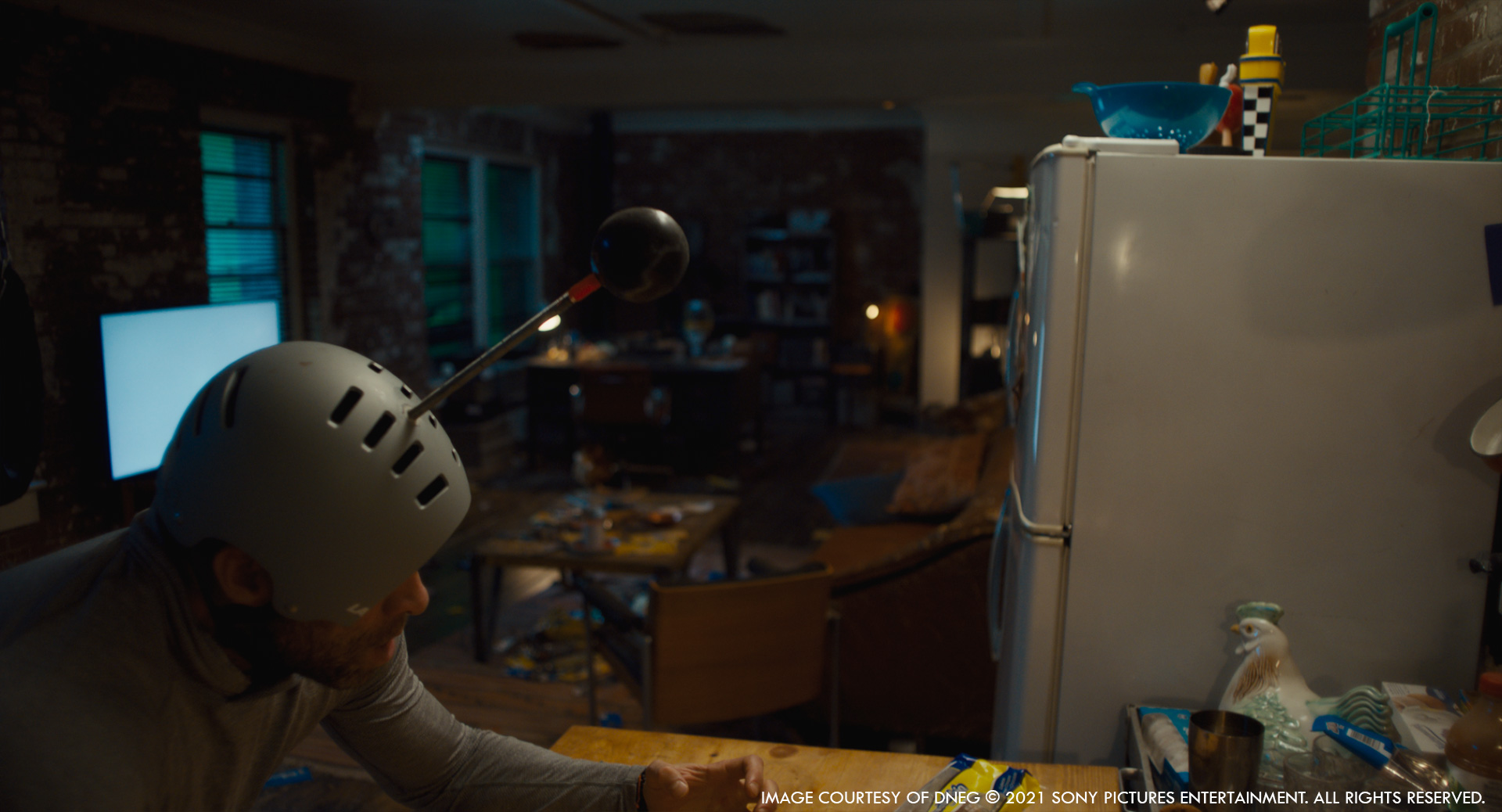
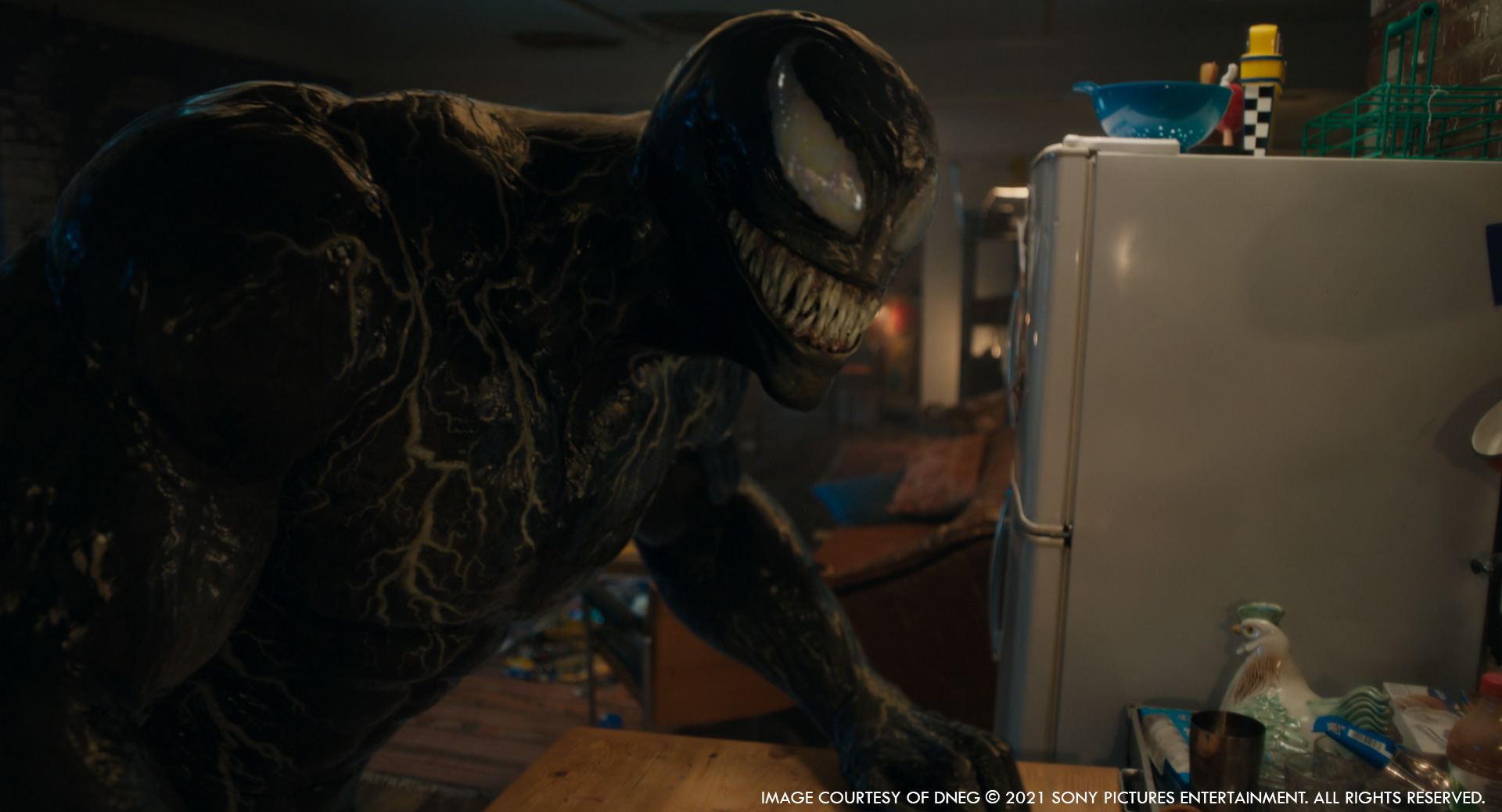
Is there something specific that gives you some really short nights?
Carnage transformations!
We knew from the outset from our experience on the first film that these shots were going to be the most difficult – there are so many elements to deal with, and in particular the change in scale is something that really needs to be imperceptible.
Our FX Supervisor in London, Federico Frassinelli, led the charge on the Carnage transformations – he had previously worked on the first Venom film and had been pivotal in defining the look of the ‘merge fight’, so he was a good fit for developing this effect. We knew that at some point during the transition from Cletus to Carnage we’d have to do a digital takeover of Woody, so an accurate digidouble was absolutely essential and was something that we began working on immediately.
As for the effect itself, we knew that it had to differ from the Venom transformation, in that Carnage’s DNA is intertwined with Cletus in a way that Venom isn’t with Eddie. So what we ended up with was a method of tearing apart Cletus from the inside out, with Carnage bursting out from within (in contrast to the Venom transformation, where Venom protectively encapsulates Eddie from the outside).
Sheena really wanted it to feel violent, as if Cletus bones were breaking apart, and we went through many, many iterations of this effect before we finalled any of these shots.
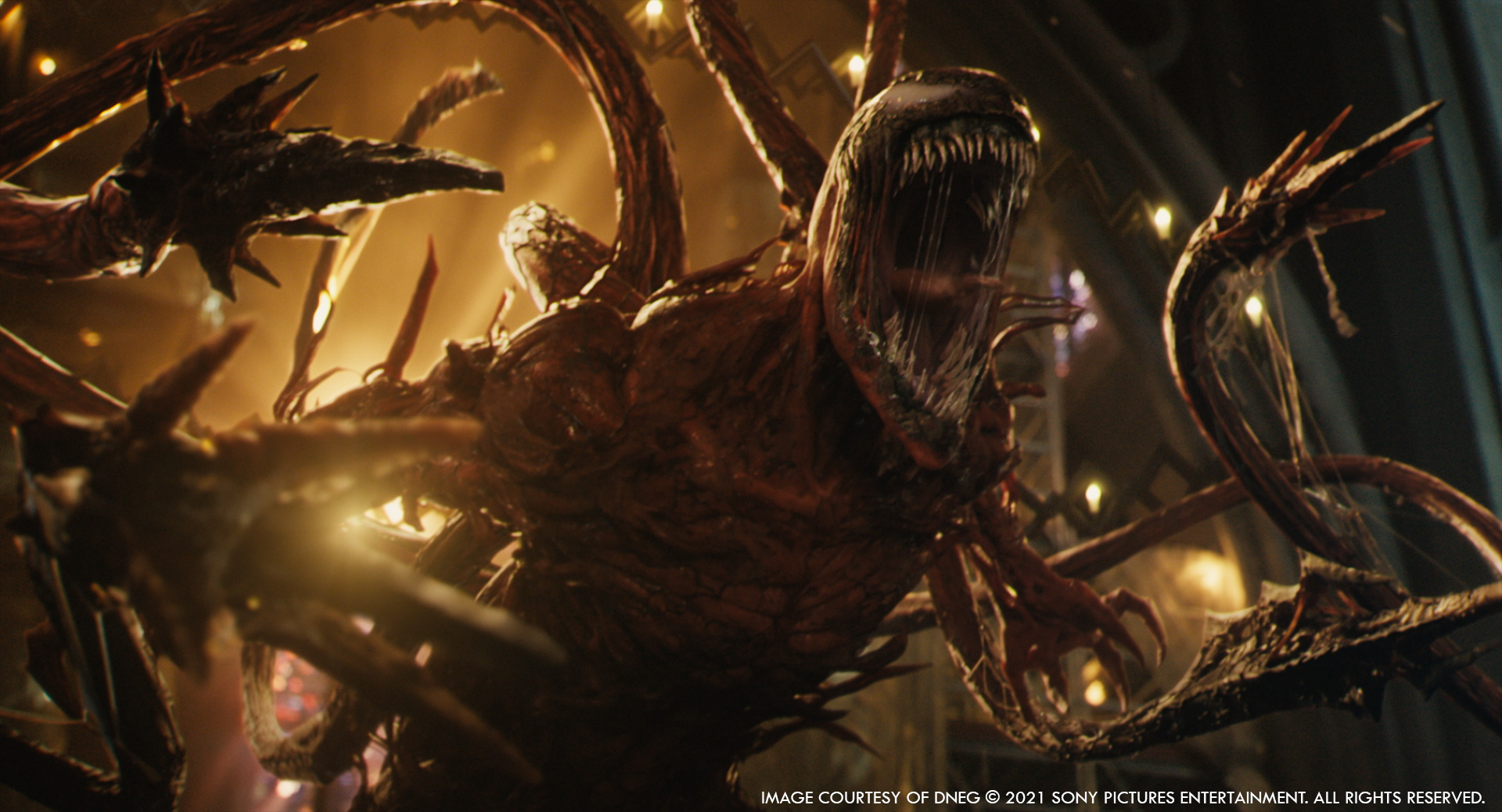
What is your favorite shot or sequence?
I have many favourite shots, but one that stands out is the ‘Vetruvian man’ shot. This is the shot where Venom throws Carnage to the rear of the cathedral – as Carnage tumbles backwards he quickly rights himself using his many tentacles, and as he is framed in silhouette against a circular stained-glass window, he then grows several more limbs and weapon attachments before hurtling towards the camera.
The shot was actually inspired by a piece of concept art done by the DNEG Art Department very early on in the show. This concept art portrayed Carnage as Leonardo da Vinci’s ‘Vitruvian man’, with multiple limbs and tentacles. The concept was immediately loved by everyone in the production team and from then on it was clear that we would eventually be reproducing this in some way in the film.
I think the final result is suitably iconic and its particularly rewarding to be able to contribute to the shot design as well as its execution.
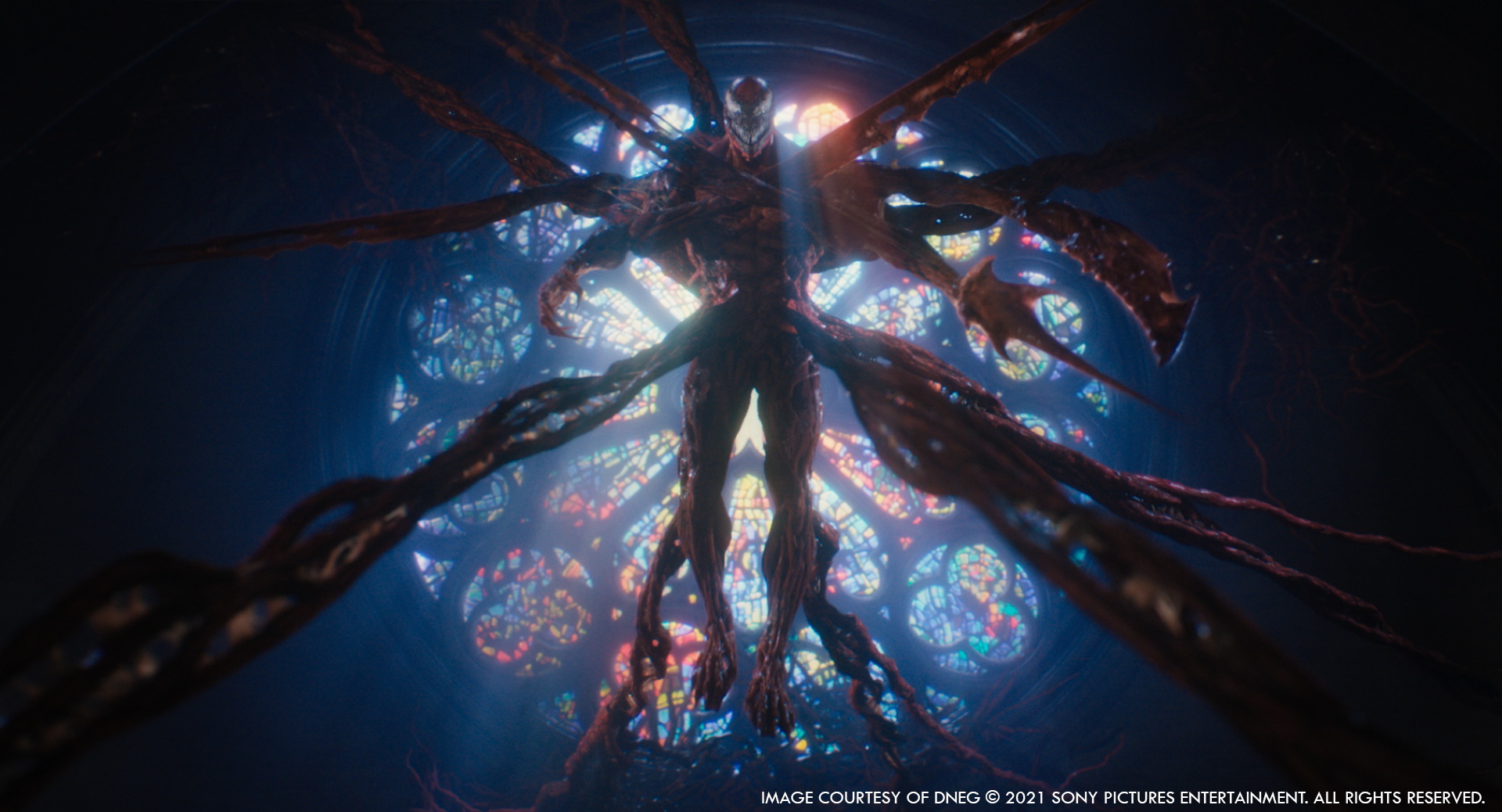
What is your best memory on this show?
Well, it’s probably the birth of my son Callum, who arrived 5 months before the end of the show… but you’re probably more interested in hearing about memories related to the film… So, from the shoot, during one of the rare quiet moments, I got to sit and chat with legendary DOP Robert Richardson (Platoon, JFK, Casino, Once Upon a Time in Hollywood), who was more than happy to share several tales from the shoots of a few of my favorite films. For a movie geek like myself I don’t mind admitting it was quite a thrill.
From post, I have countless great memories of working with the DNEG team throughout the various sites (almost all of them of course, via a Zoom window). It was just a huge privilege to work with such a talented and dedicated group of people – even with everything thrown at us over the past 2 years they made every effort to ensure that the standard of work was as high as possible, and everyone still managed to retain a sense of humour throughout.
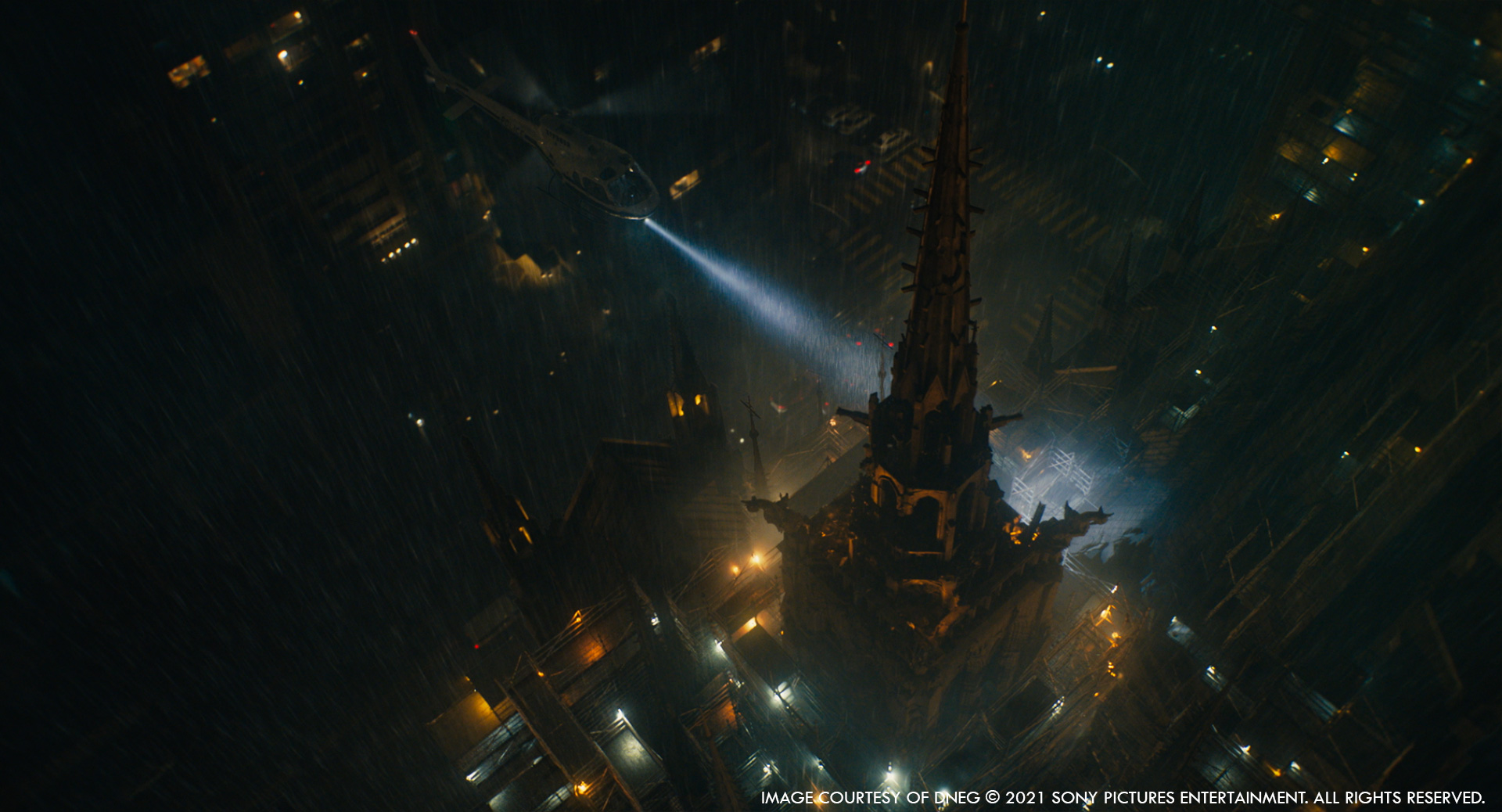
How long have you worked on this show?
In total, I worked on the show for nearly 2 years.
What’s the VFX shots count?
770 for DNEG.
What is your next project?
I’ve nothing lined up just yet… Right now, I’m enjoying some time off!
A big thanks for your time.
// Venom – The Birth of Carnage
WANT TO KNOW MORE?
DNEG: Dedicated page about Venom: Let There Be Carnage on DNEG website.
© Vincent Frei – The Art of VFX – 2021





